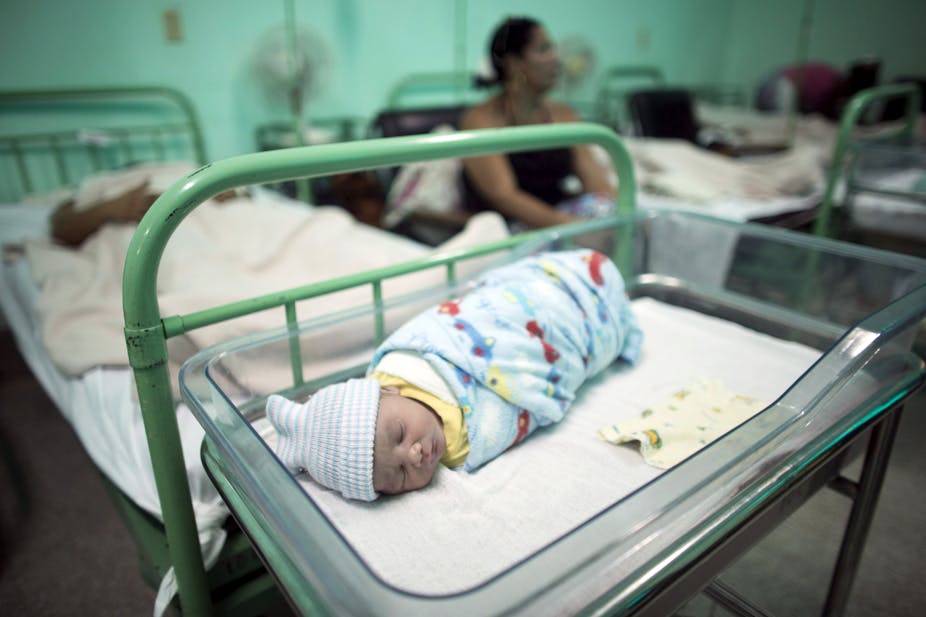Cuba has officially become the first country in the world to eliminate the transmission of HIV and syphilis from mother to child.
Margaret Chan, director-general for the World Health Organisation (WHO), described the small Caribbean island’s achievement as:
… one of the greatest public health achievements possible.
Cuba’s success is the first step in a potential victory of the fight against HIV and AIDS. Its milestone is important on several fronts in the global health governance work towards an AIDS-free generation.
It also resonates in the Millennium Development Goals to reduce child mortality, combat HIV/AIDS, malaria and other diseases as well as in the sustainable development goals to reduce the global threat of HIV and AIDS.
What lies behind Cuba’s success
Cuba’s health system is described as being a model for the world, despite a lack of resources and financial assistance. It provides access to health care for its entire population of more than 11 million and provides assistance, including provision of doctors, to other developing nations.
The healthcare system is linked to research and development, providing constant innovation in treatment and care. It is based on preventive medicine, instead of a curative model, which is more costly and less effective.
The main drivers in eliminating mother-to-child transmission were:
the combined efforts of the Cuban government;
its political tenacity in working to stop the halt of the virus; and
the efforts of Pan-American Health Organisation in ensuring Cuba adhered to its programmes to stop the progression of transmission.
Their success story is partly as a result of the Pan American Health Organisation’s access to medicines programme which increases mothers’ access to anti-retroviral drugs in the region.
In partnership with the WHO the organisation implemented two strategies: the Global Elimination of Congenital Syphilis strategy and the 2011 Global Plan towards the elimination of new HIV infections among mothers and children.
These effectively increased governments’ political will to engage with HIV-positive citizens.
These regional initiatives controlled the spread of the disease. It showed success and consistency in their approach to stem risky behaviour which could increase transmission.
Within the country there were three major drivers that broke the infection chain for transmission. A decision was taken to provide additional HIV and syphilis testing for pregnant women and their partners; women were offered caesarean deliveries instead of natural deliveries; and breastfeeding was substituted.
Cuba also initiated a nationwide HIV screening program during 1985 and 1986. HIV screening is still required for expectant mothers. Voluntary screening is also encouraged. As a result, over 23 million HIV tests have been performed. HIV-positive females receive AZT as a matter of priority from 14 weeks of gestation.
The global picture
Each year about 1.4 million infected women across the globe fall pregnant. Without anti-retrovirals, these women have a 15% to 45% risk rate of transmitting HIV, either during pregnancy, labour or breastfeeding. If anti-retrovirals are provided, the risk drops to 1% of transmission.
Currently seven of the 10 pregnant women across the globe have access to anti-retrovirals to prevent viral transmission. This is an increase in access to anti-retroviral medication in low and middle income countries and should result in increased prevention of transmission of the virus.
Of the 22 countries which account for 90% of the new HIV infections, eight have reduced new infections by more than 50% since 2009, with an additional four creeping closer towards this milestone.
Lessons southern Africa can learn
What Cuba’s success story means is two-fold. First, it is possible to eliminate mother to child transmissions, within measure. Second, the intervention and assistance of a regional organisation is effective in reducing transmission and providing access to anti-retrovirals.
Southern Africa, which has the highest rate of HIV/AIDS in the world, should take heed. The spread of the disease remains at the forefront of the development agenda for the heads of state in the Southern African Development Community (SADC).
If the SADC could mimic or adopt the same level of success that the Pan American Health Organisation has, this could significantly decrease mother to child transmission in the region.
The SADC secretariat should facilitate and co-ordinate regional issues and health care. But it is only mandated to assist with policy making that is approved by member states.
The secretariat has a HIV and AIDS unit, which assisted with a strategic framework. And most member states have adopted national policies or strategic development plans to address the country specific problems.
But co-ordination of policy is only executed once the SADC member states agree to implement the policy. A separate plan, the Pharmaceutical Business Plan, which was developed to address the need for regional provision and management of medication, has not been renewed.
Despite significant policy attention and the development of a regional cross border HIV and AIDS initiative, it remains to be seen how the region will fare in its struggle to reduce the epidemic.
Efforts to increase access to anti-retrovirals are continually hampered with problems of stock outs, limited political will and logistical difficulties. South Africa and Zambia, two prominent countries in the region, have experienced medication stock-outs. The need for a strengthened regional presence is evident.

